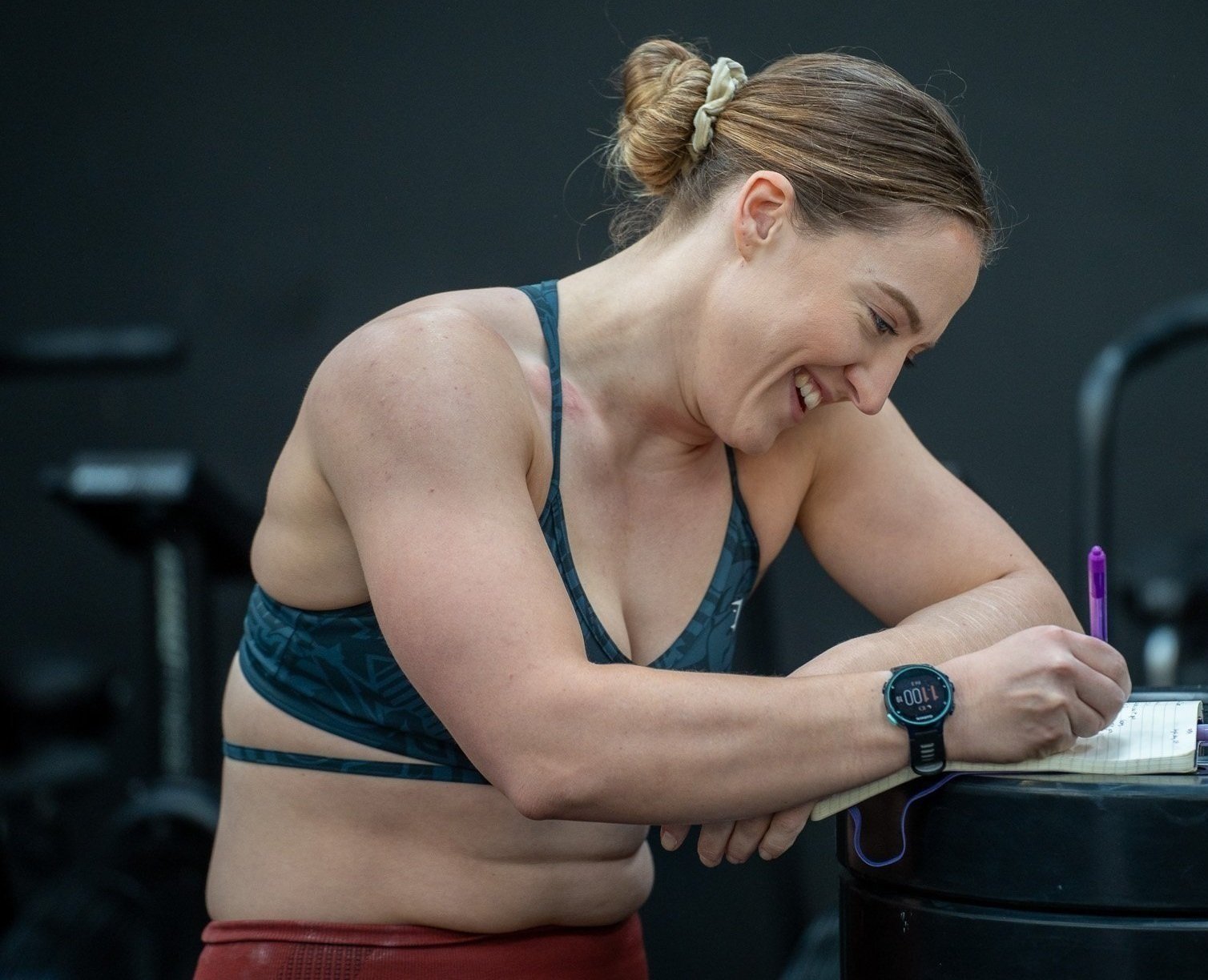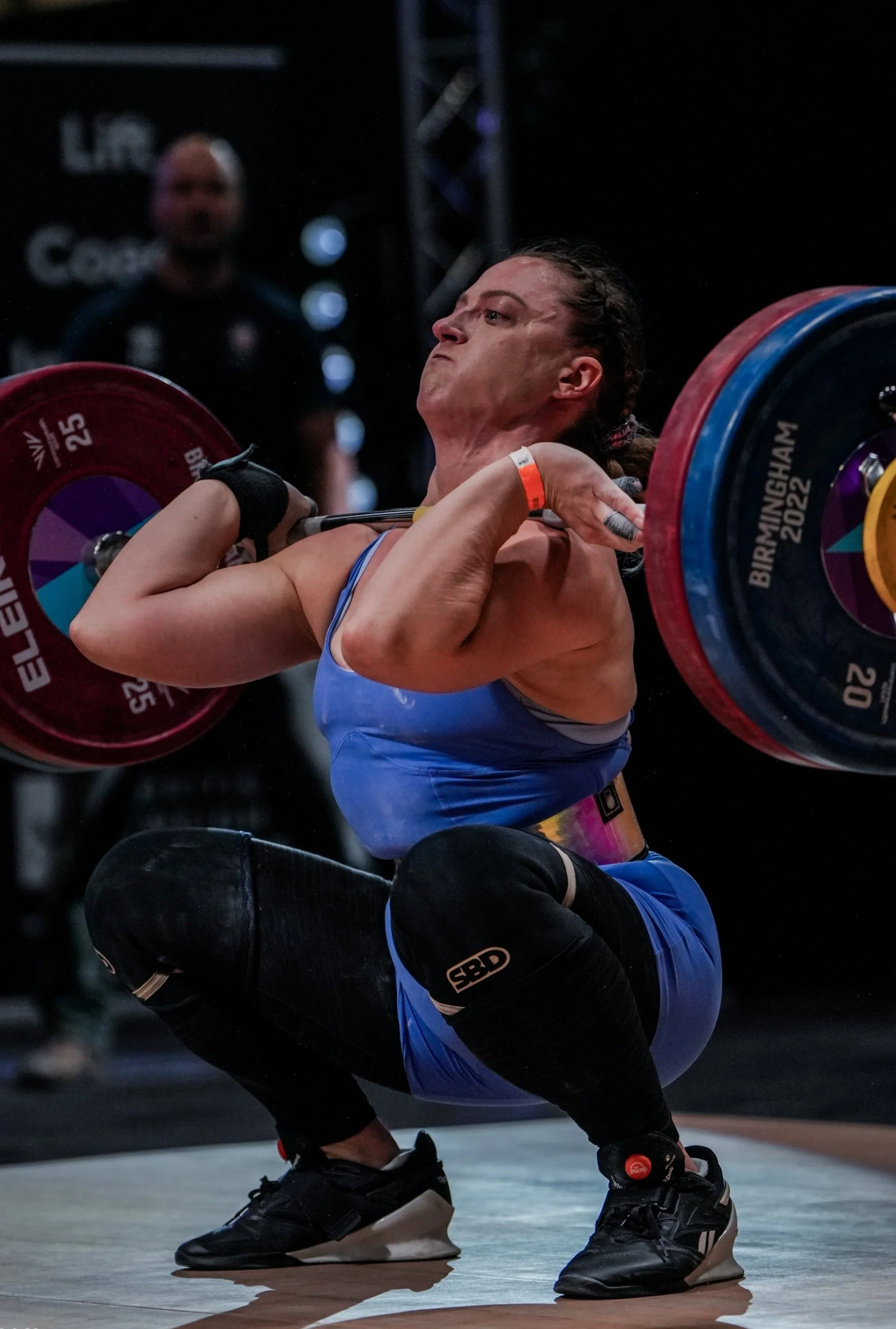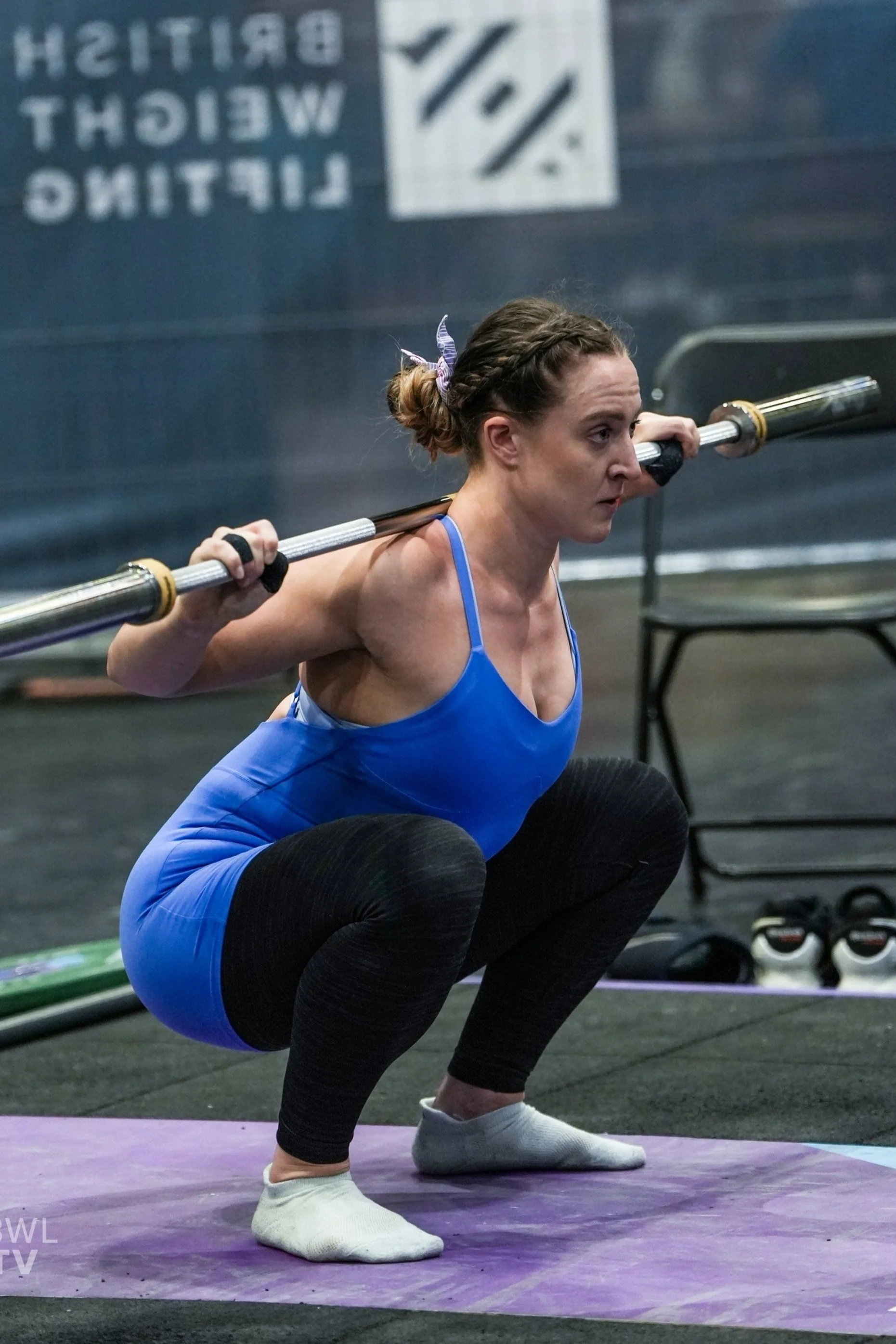From Setback to Comeback: Mastering your Mindset for Faster Injury Recovery
"The tougher the setback, the better the comeback."
Do these wise words by Bernard Osei Annang sound like something you need to hear right now? Or are you having an eye-roll moment as you’re sitting there, thinking about all the things you CAN’T do with your injury, how much progress you COULD be making if you weren’t injured, and all the people who AREN’T injured who are progressing faster than you…
I get it. I’ve been there - for an entire year, in fact.
December 2023 at the England Weightlifting Training Squad, back when I thought my injury was a short-term setback!
In October 2023, I hurt my wrist during training. It was nothing major, so at that time, I never imagined I’d be talking about it a year down the line. But here I am; from complete rest, to corticosteroid injections, to pushing too hard as soon as it started feeling a bit better and being back at square one, and even being dropped from a national squad because of it…I’ve done it all.
And during this time, I learned a lot.
Aside from learning about the injury itself - what load my wrist can handle, what exercises help, what I need to strengthen, warning sides of aggravation, etc. - I’ve learned something much more valuable: how mindset is EVERYTHING.
Injury doesn’t just affect you in the gym - it can take a serious toll on mental health if you’re not equipped to handle it.
The right mindset will make or break your recovery - from how quickly you recover, to the strength of your comeback, and your mental health throughout the process.
I’m writing this article now because I’ve finally turned a corner with my injury. I’m prepping for the English Championships in December and I’m NOT rushing the process or putting short-term performance pressure ahead of my long-term recovery.
I’m hitting strength PBs, and whilst I’m not up to my heaviest training weights yet on snatch or clean and jerk, the weights I AM hitting feel stronger than they ever did before. I’m FINALLY starting to believe that the comeback will be bigger than the setback. I’m even starting to wonder if this injury could have been a blessing in disguise (crazy, I know).
Now that I can see the light at the end of MY tunnel, I’m sharing the exact mindset strategies that I’ve developed through a combination of 10 years of competitive training plus a year of managing a major performance-limiting injury, to give you the tools to turn your setback into an even bigger comeback.
Read on to learn how you, too, can master your injury mindset!
P.S. DON’T skip out on the FREE bonus content you’ll find throughout this article!
Step 1: Focus on what you CAN do
Many people regress in every area of their training when injured for the simple reason that they don’t focus on all the things they CAN do.
You should always take stock of areas that aren’t impacted by your injury so that you can have a positive focus, rather than getting weighed down thinking about all the things your injury is stopping you from doing.
For instance, with my wrist injury, I couldn't do overhead work or front squats initially. However, I could still perform zombie squats, back squats, and various lower-body accessory strength exercises. By concentrating on these movements, I maintained a sense of progress and positive momentum, even setting myself ‘mini goals’ for exercises where I’d usually just ‘go through the motions’.
To make this step go as smoothly as possible, make sure you apply the following tips:
I like to write out my training sessions in an old-school notebook, allowing me to tick things off and easily flick back to reflect on progress!
Identify exercises that you CAN do as normal and ensure they’re included in your training
Find alternatives and work-arounds for exercises you can’t do as normal
Set goals and celebrate progress in areas you might otherwise overlook
Make a list of anything you can’t do yet. Ask yourself if there are any ways to adapt those things to get closer to them, and note down what needs to happen for you to be able to do those things - which brings us on to step 2…
(But first - a quick reminder that any movement is better than no movement at all. Even if you're limited to very basic exercises, maintaining some level of activity can help preserve muscle memory, prevent deconditioning, and boost your mood through the release of endorphins. You’ll feel better for it, I promise!)
I gained huge amounts of strength in my squat whilst dealing with this long-term wrist injury. If you’ve got an upper body injury and want to re-ignite some fire and motivation in your training, why not follow suit?
Grab our 8 week squat programme for just £39.99 and you’ll be well on your way!
Our most recent programme finisher took his back squat from 120kg to 135kg by hitting these sessions alongside classes at his CrossFit gym.
Not sure if this programme is right for you? Pop me a message and I’ll personally reply to answer your questions!
Step 2: Develop a clear but flexible plan of action
Avoid my mistake: I rushed the process to compete at the British Championships 2024 as I felt a pressure to perform - and it set me back straight after!
Another critical step to injury recovery is having a clear, step-by-step plan. This step is crucial because it not only keeps you motivated with clear milestones to work towards, it also reduces the chances of re-aggravating your injury and setting yourself back.
Before I realised how important this step was, I made the rookie error of pushing too hard in my training as soon as my wrist felt a bit better. Because I didn’t have a plan for sensible, staged progression, I flew too close to the sun, and ended up in even more pain, losing all the physical progress I had made in my rehab. BUT I hadn’t lost out on the learning experience.
Once I understood that patience and planning were key, I was able to visualise truly overcoming this injury, and set myself ‘stepping stone’ goals towards the bigger picture goal. These stepping stones also acted as a prerequisite for moving onto the next stage of the rehab plan, giving me a sense that I was moving forwards.
As a specific example, I couldn’t front squat because wrist extension hurt. So, one of the goals I set with my physiotherapist was to regain full, pain-free range of motion in the ‘prayer hands’ position. This was a prerequisite to adding front squats back into the program.
If we hadn’t set this specific goal together, I wouldn’t have thought twice about it when I achieved it. But because we’d formalised the goal, it felt like a huge milestone, which gave me a major boost of motivation. Plus, I was able to add front squats to my ‘can-do’ exercise list, and move onto the next phase of the rehab plan!
The rehab was much less glamorous than the lifting!
Use these top tips when formulating your plan:
Collaborate with a physiotherapist and your coach to create a cohesive plan
Within this plan, identify what physical milestones you need to reach to be able to add exercises to your ‘can do’ list
Recognise and celebrate ‘stepping stone’ goals that signify being a step closer to recovery
It's important to note that your rehabilitation plan should be dynamic. As you progress, your physiotherapist and coach should work together to adjust your programme, gradually reintroducing movements and increasing intensity as your body heals and you hit certain progress markers. The plan should adapt to your individual rate of progress, to ensure you're challenging yourself appropriately without risking further injury.
Step 3: Reframe your perspective
A great thing about recovering from injury is that you get the unique opportunity to see relatively fast progress, and even hit personal bests on a weekly basis.
Even getting back to overhead squats with an empty barbell was exciting progress!
Sure, they might not be lifetime personal bests, but a simple shift towards a beginner’s mindset can transform your approach to training - giving you the chance to get excited about every single step forwards you make, even when working with lighter weights or modified exercises.
For me, when I was able to snatch balance again, I was using a fraction of the weights I’d previously lifted. In the past, a 50kg snatch balance would have been my second warm up, but now, it was the heaviest I could go. And yet, because I was ‘tricking’ myself into that beginner’s mindset, I wasn’t thinking about the 100kg I used to do. I was thinking about the 45kg I’d managed the week before, and the 40kg the week before that, and how exciting it was that I was seeing week-on-week improvements.
I could see that if I just kept going, working hard and being patient, I’d return to my previous weights, this time stronger due to all the rehab exercises and leg strength I’d been doing.
Guess what? This week I’m back up to 90kg - watch this space!
There are plenty of other ways you can use this reframing technique - here’s a few more examples:
Treat each training session as if you're starting from scratch
Celebrate small improvements as if they were personal bests
Use this time to refine your technique and prevent future injuries
Check out this video where I discuss this in even more detail!
Bonus tip: Consider keeping a recovery journal to track your progress. This can be particularly helpful on days when you feel discouraged. Looking back at where you started can provide a tangible reminder of how far you've come, even if it doesn't always feel like it in the moment.
Step 4: Broaden your horizons
Now we’ve covered most of the tips relating to how you approach your training and recovery itself, it’s time to look outside of the gym. And since you’ve already made a plan and set yourself some goals to focus on, it’ll be much easier to implement this next step.
This step is important and one that most people overlook - from Olympic gold medallists to everyday gym-goers - because we don’t notice there’s a problem until it’s too late. Then, once we find ourselves injured, ill, or out of training for any reason, we’re left with an empty hole in our lives that training once filled.
At it’s worst, we’re left with an identity crisis:
“Who am I, if not an athlete?”
“What do I enjoy doing in my free time, if not going to the gym?”
“What hobbies or relationships do I have outside of training?”
“What else gives me a sense of worth, purpose, and self-esteem, if not working hard and seeing progress in the gym?”
In fact, when my wrist was at its worst, my coach dropped my training days from 6 per week to 4. As someone who’s always feeling desperate for more hours in the day, you’d think this would come as a welcome relief. And yet, I really struggled with the change at first - I didn’t have routine to structure my work and other responsibilities around, and training less meant I had to make big changes to my nutrition, too (something I support my Performance Macro Coaching clients with every week as they navigate life’s constant changes!)
However, once I realised why I was struggling with this change, I was able to get to work on a solution:
Similarly to focusing on what you CAN do in training, the key is to focus on what you CAN do in life! I chose to see the opportunity to grow my business, settle into my new home, and reconnect with friends and family.
Any periods of reduced training can also be an excellent time to focus on other aspects of your athletic performance. For example, you might address certain skills or accessory strength work that would otherwise be difficult to fit into your sessions, dial in your nutrition, or work on mental skills like visualisation.
Setting goals around other lifestyle changes that positively impact your overall health and wellbeing is a great way to stay motivated, too. I used the initial lack of structure to figure out MY perfect morning routine, which set me up for a happier, more energised and productive day. Then, I created a step-by-step system for you to do the same - which you can find FREE here, and download the accompanying FREE workbook right here.
Keep these tips in mind for maximum results:
Invest energy in neglected hobbies or interests
Spend more time with friends and family
Focus on personal growth or career development
Recognise that your worth isn't solely tied to your athletic performance
By doing so, you'll be better equipped to handle future setbacks, both in and out of your sport. Exercise is great for mental health, but if you find yourself spiralling into depression the moment you can’t do it, this is a clear indicator that a more holistic approach to managing your wellbeing and sense of self is needed.
Why not use your nutrition to accelerate your recovery?
Grab any of my FREE guides to get started - from meal prep to protein, I’ve got you covered - just click the image below!
How can we help you turn your setback into a comeback?
Are you still flailing a little or want just a bit more help to get you back on your feet after injury, illness, or some other life event that’s thrown you off course?
No problem! At Georgia Radley Nutrition, we pride ourselves on putting health, performance and long-term goals ahead of short term, quick fixes. We understand that success with training and nutrition isn’t just about knowing ‘what’ to do - it’s about having the support, accountability, and understanding to put it into practice.
That means you don't have to struggle through this setback alone. That's what we're here for.
Click here to learn more about how our coaching can help keep you on track with your long-term goals, even if training is currently taking a backseat or needing to be adjusted.
From macro coaching to bespoke coaching covering both nutrition and training, we’ve got options to suit your budget and support needs.
We can't wait to work with you.
Questions? Get in touch HERE and I’ll get back to you ASAP!
P.S. Did you see last week’s post all about creatine supplements? It covers everything you need to know about the most researched workout supplement out there - including common myths to look out for! We’d love to hear what you think!
Oh, and don’t forget to check out our FREE guides here and workout programmes here









